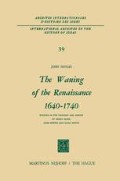Abstract
It may seem perverse to find characteristics of Romanticism in the work of a pre-Augustan poet; but only in the context of an emerging modernity, figuring the break-up of Renaissance literature and die foretaste of Romantic literature, can we make sense of More’s poetry, and relate it to a principle common to his philosophical and theological work. More was the only Cambridge Platonist to write poetry, and though few would judge his reputation enhanced by this work, it would be misleading not to take it into serious consideration. Such a consideration would correct the traditional view, implied in Coleridge’s attitude towards the Cambridge Platonists, that while More and Cudworth’s ideas could be regarded by the Romantic poets as important for aesthetic theory, their literary performance was without value. This divorce between More’s poetic achievement, for what it is worth, and his relevance to aesthetic theory, obscures the homogeneity of More’s modernity. More has a position in literature corresponding to his position in philosophy and theology. This can be established firtsly by examining his relevance to aesthetic theory, not only in an absolute Coleridgean sense, but also relative to his own literary context at the watershed between Renaissance and modern; and secondly by putting into evidence his literary achievement.
Access this chapter
Tax calculation will be finalised at checkout
Purchases are for personal use only
Preview
Unable to display preview. Download preview PDF.
References
See The Enneads, ed. and trans. Stephen MacKenna (2nd ed.; London: Faber, 1956), pp. 282–287 (IV, iii, 26–32). See also Bullough’s gloss in More’s Philosophical Poems, p. 187.
Gerard Manley Hopkins, Letter to A. W. M. Baillie, 10 September 1864, in A Selection of his Poems and Prose, ed. W. H. Gardner ( London: Penguin Books, 1953 ), p. 156.
Basil Willey, The 17th Century Background (London: Penguin Books, 1962), p. 145.
Lord Herbert of Cherdury, Poems, ed. G.C. Moore Smith (Oxford: Clarendon press, 1923 ), P. xx.
Quoted in John Hollander, The Untuning of the Sky: Ideas of Music in English Poetry 1500–1700 (Princeton: University Press, 1961), p. 295. Descartes’ Compendium Musices appeared in 1618.
James Howell, “Upon a Fit of Disconsolation, or Despondency of Spirit”, from Poems on Several Choice and Various Subjects (1663), printed in Leslie Birkett Marshall (ed.), Rare Poems of the 17th Century ( Cambridge: University Press, 1936 ), p. 121.
See especially Joseph Addison, “The Spacious Firmament on High,” The Spectator, No. 465, in Works, ed. Henry G. Bohn (6 vols.; London: Bohn’s British Classics, 1856), III, 485–486.
Richard Savage, Poetical Works, ed. C. Tracy (Cambridge: University Press, 1962), 129, 133, 144.
Richard Glover, “Poem on Sir Isaac Newton” (1728), line 11. Chalmers, XVII, 13.
Thomas Vaughan, The Man Mouse Taken in a Trap (1650), Episdc Dedicatory, as quoted in More, Philosophical Poems, ed. Bullough, p. lxix.
Horace, Odes, I, 22. See Maren-Sofie Rostvig, The Happy Man: Studies in the Metamorphoses of a Classical Ideal (2 vols.; “Oslo Studies in English,” Nos. 2 and 7; Oslo: Akademisk FoHag; Oxford: Blackwell, 1954–1958), I, 201.
See especially Dyer’s Grongar Hill (1726). Mallet’s The Excursion f 1729) and Savage’s The Wanderer (1729).
Kenneth MacLean, John Locke and English Literature of the 18th Century ( New Haven: Yale University Press, 1936 ), p. 57.
Henry Brooke, Redemption (1772). Chalmere, XVII, 442.
James Hervey, Meditations and Contemplations ( London: T. Hamilton, 1808 ), p. 325.
George Eliot, Essays, ed. Thomas Pinney (London: Routledge and Kegan Paul, 1963), p. 368. This essay, entitled “Worldliness and Other Worldliness: the Poet Young,” was originally published in the Westminster Review, LXVII (January 1857), 1–42.
Rights and permissions
Copyright information
© 1971 Martinus Nijhoff, The Hague, Netherlands
About this chapter
Cite this chapter
Hoyles, J. (1971). Aesthetics: From Metaphysical to Romantic. In: The Waning of the Renaissance 1640–1740. International Archives of the History of Ideas/ Archives internationales d’histoire des ideés, vol 39. Springer, Dordrecht. https://doi.org/10.1007/978-94-010-3008-3_4
Download citation
DOI: https://doi.org/10.1007/978-94-010-3008-3_4
Publisher Name: Springer, Dordrecht
Print ISBN: 978-94-010-3010-6
Online ISBN: 978-94-010-3008-3
eBook Packages: Springer Book Archive

